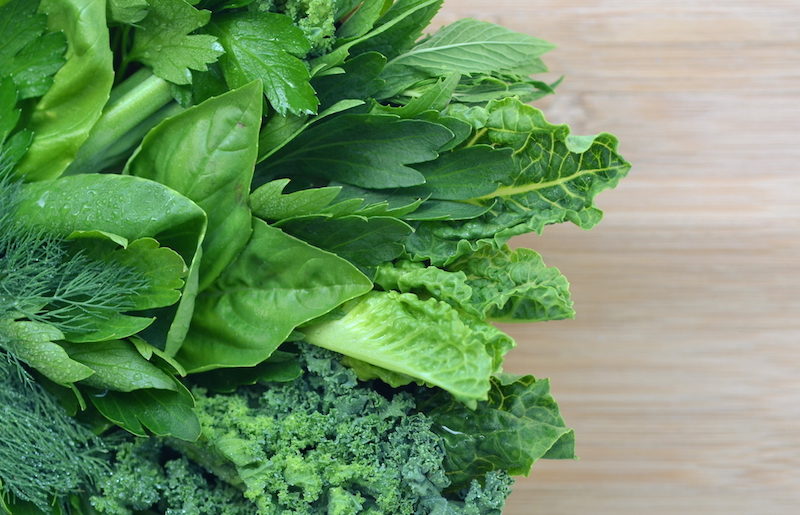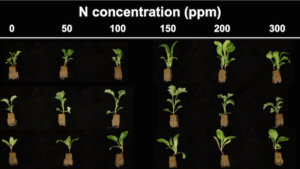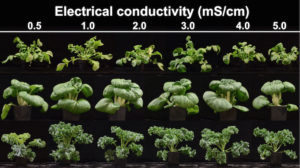
Fertilizing Specialty Leafy Greens
Leafy greens are some of the most popular crops to grow hydroponically. They are popular with consumers, have a quick crop time, and don’t require specialized structures like trellises or a high gutter height. Specialty greens including arugula (Eruca sativa), kale (Brassica oleracea), pac choi (Brassica rapa var. chinensis) and Swiss chard (Beta vulgaris) are commonly grown in water-culture hydroponic systems such as nutrient-film technique (NFT) or deep-flow technique (DFT), which use recirculating nutrient solutions.
In order to produce healthy seedlings for transplanting and maximize yields during finishing, appropriate fertilizer concentrations should be used. With no solid research to refer to for species-specific recommendations for seedling propagation and finishing, we conducted a series of experiments to answer these questions.
The Experiments
In the first experiment, arugula, ‘Starbor’ kale, ‘Win-Win’ pac choi and ‘Fordhook Giant’ Swiss chard were sown in 162-cell phenolic foam propagation sheets with a top groove (Oasis HortiCubes XL; Smithers-Oasis) placed in 1,020 flats with drainage holes. Immediately after seeding and every day throughout the experiment, flats were irrigated with 25, 50, 100, 150, 200, or 300 mg·L–1 nitrogen from a complete, balanced, water-soluble fertilizer (Jack’s Hydro FeED 16N-4P-17K; J.R. Peters) every day throughout the experiment. Flats were placed on top of expanded metal rolling benched in a glass-glazed greenhouse with 75° F days and 70° F nights and a daily light integral (DLI) between 12 and 14 mol∙m−2∙d−1.
Seedling data were collected 15 (pac choi), 16 (arugula and Swiss chard) or 17 days (kale) after seeding. Heights of 10 seedlings were taken from the top of the germination substrate to the top of the growing tip. Then, 40 seedlings were harvested by cutting at the top of the substrate, triple rinsing with deionized water, and placed into a brown paper bag to dry for dry weight. After dry weights were recorded, shoot tissue was submitted for nutrient concentrations analyses at a commercial laboratory.
In the second experiment, seedlings of arugula, ‘Starbor’ kale, ‘Win-Win’ pac choi, and ‘Fordhook Giant’ Swiss chard were transplanted into deep-flow technique (DFT) hydroponic systems. Nutrient solutions were maintained at an EC of 0.5, 1.0, 2.0, 3.0, 4.0 or 5.0 mS·cm–1 using the same complete, balanced, water-soluble fertilizer (Jack’s Hydro FeED 16N-4P-17K; J.R. Peters) as in the seedling experiment. The pH was maintained at 5.8 using potassium hydroxide.
Throughout the entire experiment, the EC and pH were constantly maintained at target values using auto-dosers that measured and corrected EC and pH as needed. The DFT systems were grown in a similar glass-glazed greenhouse as the seedlings were, with 73° F days and 66° F nights and a daily light integral (DLI) between 12 and 14 mol∙m−2∙d−1.
Finished plant data were collected two (arugula), three (pac choi and swiss chard), or four weeks (kale) after transplanting seedlings into DFT systems and initiating treatments. Height, width and leaf greenness were measured, after which plants were harvested and fresh and dry weights were collected.
Increasing Fertilizer Promotes Seedling Growth
In the first experiment, fertilizer concentration had varying effects on plant growth. For all four species, height was unaffected by fertilizer concentration. Alternatively, the dry weight increased with fertilizer concentration for arugula, kale and Swiss chard up to 200-ppm nitrogen, but not for pac choi. Although we did not collect data on leaf area, as fertilizer increased, so did leaf size.
Mineral nutrient concentrations were affected differently by fertilizer concentration. For example, nitrogen (N), phosphorus (P), potassium (K), and magnesium (Mg) increased with increasing fertilizer concentration, whereas calcium (Ca) and sulfur (S) decreased. For micronutrients, while copper (Cu) and boron (B) were largely unaffected by fertilizer concentration, iron (Fe), manganese (Mn) and zinc (Zn) increased with increasing fertilizer concentrations.

row) seedlings grown in a 162-cell sheet of phenolic foam propagation
cubes and fertilized with 0- to 300-pm nitrogen from a complete, balanced
hydroponic fertilizer daily.
Based on our research, there are a few pointers to fertilizing specialty herb seedlings. First, seedling growth is promoted by increasing fertilizer concentration, up to 200-ppm nitrogen. The effect of seedling size is not totally clear — does a larger seedling finish more quickly? This makes sense, though we do not have data to support that fact. One challenge associated with growing large seedlings is separating them for transplanting. The large leaves on bigger seedlings can get tangled together when trying to separate sheets of seedlings to transplant individual plugs.
In addition promoting growth, increasing fertilizer concentration increased tissue nutrient concentrations for most elements (N, P, K, Mg, Fe, Mn and Zn). This makes sense, as increasing EC increases mineral nutrient concentrations available for plants to take up. On the other hand, increasing EC resulted in decreasing Ca and S tissue concentrations. The likely cause of reductions in tissue Ca and S was the “dilution effect,” whereby the increase in plant growth caused the percentage of Ca and S in tissue to decline. The total Ca and S in specialty green seedlings did not decrease with increasing EC, supporting our hypothesis. Regardless of tissue nutrient values, all seedlings had a healthy appearance and had no deficiency or toxicity symptoms.
Healthy specialty green seedlings can be grown with 25- to 200-ppm nitrogen. As the fertilizer concentration increases, so does shoot growth. Therefore, fertilizer concentrations can be used to push growth of overhead-irrigated seedlings. If sub-irrigation is used to fertilize seedlings, using 150- or 200-ppm nitrogen solutions may not be advisable, since young plants can be sensitive to high salt levels; in our study, the overhead irrigation leached excess salts, whereas sub-irrigated seedlings would accumulate them.
Crops Vary In Their Nutrient Requirements During Finishing
In the second experiment, the height and width of plants were largely unaffected by nutrient solution EC. Alternatively, plant weight responded differently to increasing fertilization among specialty green species. Fresh and dry weight of arugula and pac choi decreased as EC increased. Alternatively, as EC increased from 0.5 to 2.0 mS·cm–1 swiss chard weight increased, but decreased as EC further increased from 2.0 to 5.0 mS·cm–1. While there was no difference between kale fresh weight between 1.0 and 5.0 mS·cm–1, plants grown in 0.5 mS·cm–1 weighed less than the other EC treatments.
The tissue nutrient concentrations of finished plants were similar in the finishing experiment as they were in the seedling experiment, in that tissue nutrient concentrations increased for most macro- and micronutrients. Similarly, Ca decreased with increasing EC. However, Mg decreased with increasing EC, while S increased. Only Mn in arugula and pac choi and B and Fe in swiss chard, decreased with increasing EC.

Nutrient solutions for specialty greens can be managed differently for the different species. For arugula and pac choi, the EC should be maintained between 0.5 and 2.0 mS·cm–1, as greater concentrations diminish yields. Alternatively, swiss chard should be grown in solutions maintained around 2.0 mS·cm–1; if the EC is lower (0.5 or 1.0 mS·cm–1) or higher (3.0 to 5.0 mS·cm–1) yield decreases. Finally, nutrient solutions for kale should be at least 1.0 mS·cm–1, as yields are lower if EC is <1.0 mS·cm–1; however, yield did not increase as EC increased above 1.0 mS·cm–1. While these recommendations are species-specific, specialty greens are frequently grown in a poly-culture, with multiple species provided with the same nutrient solution.
The increasing tissue nutrient concentrations in response to increasing EC makes sense, given that increasing nutrient solution EC provides more nutrients to plants for uptake. While Ca and S declined with increasing fertilizer concentration in the seedling experiment, we found that Ca and Mg decreased with increasing EC in the current experiment. Again, we attribute some of this to the dilution effect. However, we may have also seen decreasing Ca and Mg due to competition from K. Since we used potassium hydroxide (KOH) to raise pH to keep it at our target (5.8), the increasing K from these additions may have competed with Ca and Mg for uptake. Regardless, no Ca or Mg deficiencies were observed on any species regardless of tissue concentrations. The only nutrient deficiency symptom observed in our study was a S deficiency on kale grown at 0.5 mS·cm–1. The new growth of kale had chlorotic leaves that were very brittle; however, this was the only apparent at the lowest nutrient concentration, and was not present when kale was grown at higher ECs.
Take Home
Specialty greens are an increasingly popular crop, and this work aimed to improve nutrient management from propagation through finishing. Healthy seedlings can be grown at a range of tissue concentrations, and growth is promoted up to 200-ppm nitrogen. While arugula and pac choi have low EC requirements during finishing, kale and Swiss chard should be provided with nutrient maintained at >1.0 mS·cm–1 or ~2.0 mS·cm–1 to maximize yield and quality.


 Video Library
Video Library 




















